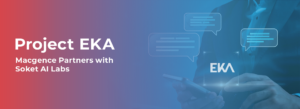SLM vs. LLM: The Transformation of AI Language Models
The domain of artificial intelligence (AI) has been dominated by the groundbreaking advancements of language models, transforming the way businesses and individuals interact with technology. From automating customer service to creating human-like writing, language models significantly shape our digital experiences. While Large Language Models (LLMs) like OpenAI’s GPT-4 remain widely recognized for their vast capabilities, Small Language Models (SLMs) are gaining traction in 2024 as a practical, efficient alternative for many applications.
But what exactly are SLMs, and how do they differ from their larger counterparts? And more importantly, why is this emerging shift important for businesses? Let’s explore.
What Are Small Language Models (SLMs)?
SLMs are compact AI models designed to process, understand, and generate natural language content efficiently. Unlike their larger siblings, LLMs, which can have hundreds of billions of parameters, SLMs typically range from a few million to a few billion parameters. These parameters are internal variables the AI learns during training to make predictions or generate responses.
Key Features of SLMs
- Compact design: SLMs use a smaller transformer-based architecture, resulting in reduced computational demands.
- Efficiency: They require less memory and computational power, making them ideal for edge devices or environments with limited resources.
- Focused application: SLMs excel in specialized tasks, tailored to specific business domains.
Advantages of SLMs
- Resource Efficiency
SLMs are perfect for environments with limited hardware capacity, such as mobile devices or offline applications.
- Cost-Effective
The smaller size of SLMs leads to reduced operational costs, making them accessible even for small businesses.
- Data Security
Since SLMs can be deployed locally without relying on external APIs, they minimize the risk of data leakage—an important consideration for enterprises handling sensitive information.
- Specialization
SLMs can be trained on specific datasets to suit niche needs, providing targeted, actionable insights and accurate responses.
- Real-Time Responsiveness
With faster inferencing capabilities, SLMs are ideal for real-time applications such as live chat support and robotic process automation (RPA).
SLM Training Techniques
Training SLMs often involves model compression techniques to achieve efficiency while retaining accuracy. Common approaches include:
- Knowledge Distillation
A smaller “student model” learns from a larger “teacher model” without training on massive volumes of raw data.
- Pruning
Removing redundant parts of a neural network reduces its size and computational overhead.
- Quantization
Converts high-precision data to lower precision to make models lighter and faster.
What Are Large Language Models (LLMs)?
On the other side of the spectrum, LLMs, such as OpenAI’s GPT-4 or Google’s PaLM, are known for their enormous scale, sometimes exceeding trillions of parameters. These models are built to perform a wide range of tasks, often with human-like fluency.
Key Features of LLMs
- Wide-ranging abilities: Able to handle diverse applications, from answering complex questions to generating creative content.
- Deep understanding: A vast parameter size allows LLMs to grasp intricate nuances in language.
Advantages of LLMs
- Comprehensive Knowledge
LLMs excel at tasks requiring broad or generalized language understanding.
- Versatility
These models handle everything from general writing tasks to sophisticated problem-solving without extensive retraining.
- Creativity
Larger training datasets allow LLMs to produce highly creative outputs, such as original stories or extensive reports.
However, LLMs demand significantly more computational resources, incur higher costs, and are less specialized for niche domains.
Key Differences Between SLMs and LLMs
1. Parameter Size and Computational Power
SLMs operate with fewer parameters, which makes them more efficient, while LLMs rely on their sheer scale to deliver broad capabilities at higher costs.
2. Training Data and Specialization
SLMs are trained on focused datasets for specific tasks, while LLMs use vast, diverse datasets for broader applications.
3. Performance and Efficiency
SLMs are faster and more efficient on smaller hardware setups, making them ideal for quick, real-time applications. LLMs perform best with robust, high-powered infrastructure.
4. Cost and Accessibility
SLMs are cost-effective and accessible to smaller organizations, whereas LLMs remain expensive to implement and maintain.
5. Data Security and Privacy
SLMs, often deployable offline, offer more secure and private solutions than LLMs, which rely on APIs that could expose sensitive information.
Use Cases for SLMs
1. Real-Time Applications
SLMs are ideal for real-time applications like chatbots, voice assistants, and customer support automation.
2. Sentiment Analysis
Specialized SLMs excel in tasks requiring precise outputs, such as identifying customer sentiment from reviews.
3. Coding Assistance
SLMs trained on specific programming languages provide lightweight, efficient coding and debugging support.
4. Niche Business Domains
For industries like healthcare or finance, SLMs fine-tuned on domain-specific datasets offer superior accuracy and security.
Examples of Effective SLMs
- DistilBERT – A scaled-down version of Google’s BERT model.
- Gemma – Known for flexibility with 2, 7, and 9 billion parameter sizes.
- GPT-4o Mini – A cost-effective alternative to GPT-4o.
- Granite 3.0 – Features 2 and 8 billion parameter options.
- Phi-2 – Specializes in mathematical reasoning and coding tasks.
- Llama 3.2 – Sustainable model offering 1 and 3 billion parameter sizes.
The Future of Language Models
The growing prominence of SLMs in 2024 highlights a key industry shift. Organizations are moving towards a portfolio strategy, combining both SLMs and LLMs based on specific requirements.
SLMs are expected to see advancements in self-supervised training and enhanced architecture efficiency. Additionally, enterprises can leverage advancements like Retrieval Augmented Generation (RAG) for even more accurate, specialized outputs.
Ultimately, the combination of SLMs and LLMs will provide tailored solutions to diverse business challenges, pushing AI adoption further into the mainstream.
Why Macgence Supports SLM Innovation
At Macgence, we specialize in providing high-quality data to train AI/ML models, helping businesses create efficient, domain-specific SLMs. Whether you aim to streamline customer experiences or enhance real-time analytics, our curated datasets ensure accuracy and relevancy at every stage.
FAQs
Ans: – SLMs are ideal for tasks requiring fast, specialized output, high data security, or applications with limited computational resources.
Ans: – Not necessarily. When fine-tuned for specific applications, SLMs offer comparable accuracy to LLMs for focused tasks.
Ans: – Yes, SLMs are lightweight and can run efficiently on basic setups, making them perfect for smaller organizations or mobile applications.
You Might Like
February 28, 2025
Project EKA – Driving the Future of AI in India
Artificial Intelligence (AI) has long been heralded as the driving force behind global technological revolutions. But what happens when AI isn’t tailored to the needs of its diverse users? Project EKA is answering that question in India. This groundbreaking initiative aims to redefine the AI landscape, bridging the gap between India’s cultural, linguistic, and socio-economic […]
March 7, 2025
What is Data Annotation? And How Can It Help Build Better AI?
Introduction In the world of digitalised artificial intelligence (AI) and machine learning (ML), data is the core base of innovation. However, raw data alone is not sufficient to train accurate AI models. That’s why data annotation comes forward to resolve this. It is a fundamental process that helps machines to understand and interpret real-world data. […]
March 6, 2025
Vertical AI Agents: Redefining Business Efficiency and Innovation
The pace of industry activity is being altered by the evolution of AI technology. Its most recent advancement represents yet another level in Vertical AI systems. This is a cross discipline form of AI strategy that aims to improve automation in decision making and task optimization by heuristically solving all encompassing problems within a domain. […]
March 5, 2025
Use of Insurance Data Annotation Services for AI/ML Models
The integration of artificial intelligence (AI) and machine learning (ML) is rapidly transforming the insurance industry. In order to build reliable AI/ML models, however, thorough data annotation is necessary. Insurance data annotation is a key step in enabling automated systems to read complex insurance documents, identify fraud, and optimize claim processing. If you are an […]





